Analysis of Leadership, Stewardship and Organizational Issues at BP
VerifiedAdded on 2020/04/01
|9
|2262
|162
Report
AI Summary
This report provides an in-depth analysis of BP's leadership, stewardship, and organizational issues, particularly focusing on the factors that contributed to the company's major oil spills and controversies. The report examines various organizational theories, including agency theory, institutional theory, bureaucracy theory, stakeholder theory, and stewardship theory, to understand the failures within BP's management structure. It highlights specific issues such as mismanagement, cost-cutting measures that compromised safety, and a top-down, non-directive organizational structure that hindered effective communication and accountability. The analysis reveals how these issues led to a culture of negligence, disregard for employee concerns, and ultimately, catastrophic events. The report concludes with recommendations for leaders at BP, emphasizing the importance of open communication, proactive assessment, and a focus on serving the company, its people, and the community. The report uses the agency theory to explain the failures and suggests ways to improve the organizational structure at BP to avoid future mishappenings.
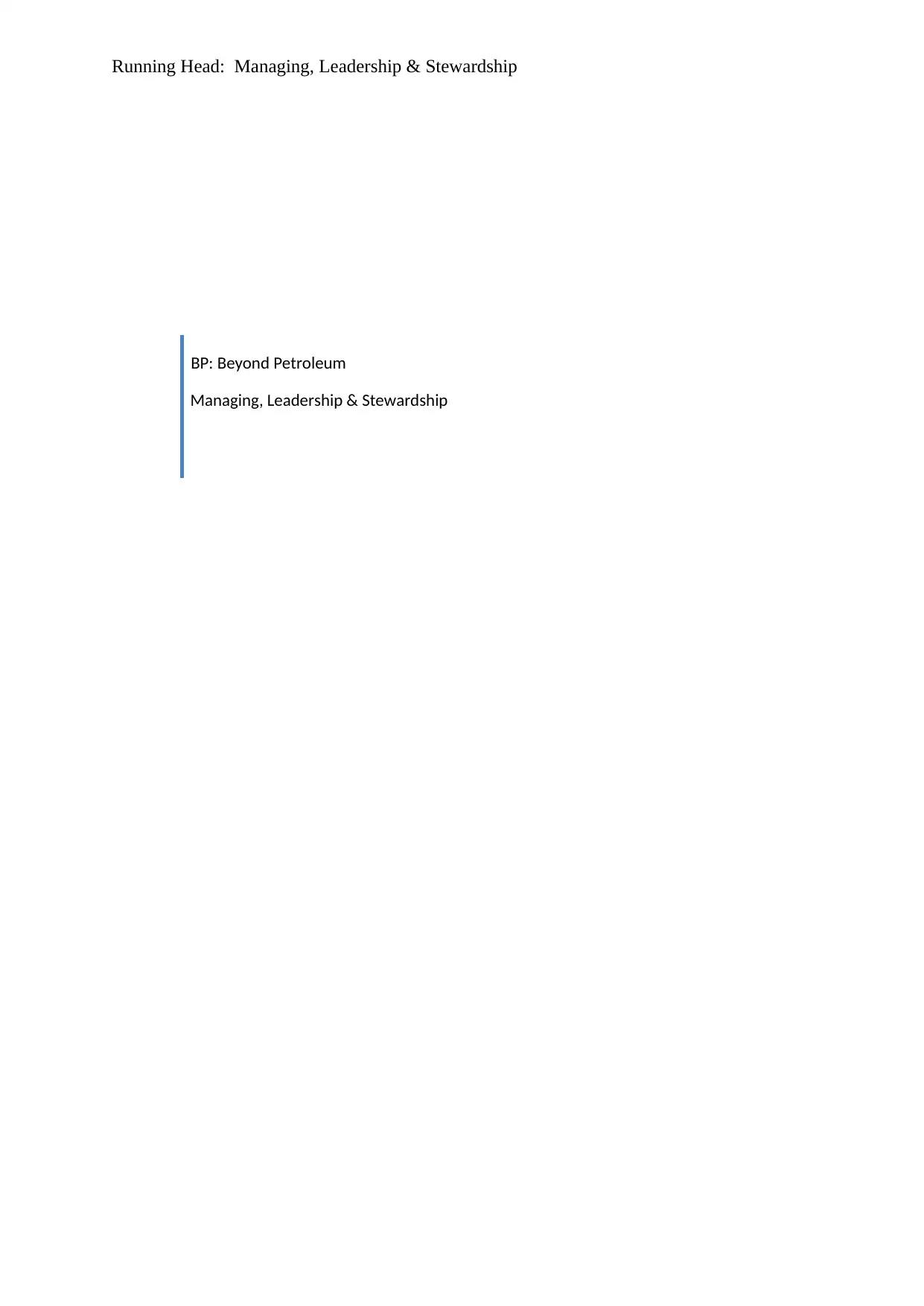
Running Head: Managing, Leadership & Stewardship
BP: Beyond Petroleum
Managing, Leadership & Stewardship
BP: Beyond Petroleum
Managing, Leadership & Stewardship
Paraphrase This Document
Need a fresh take? Get an instant paraphrase of this document with our AI Paraphraser
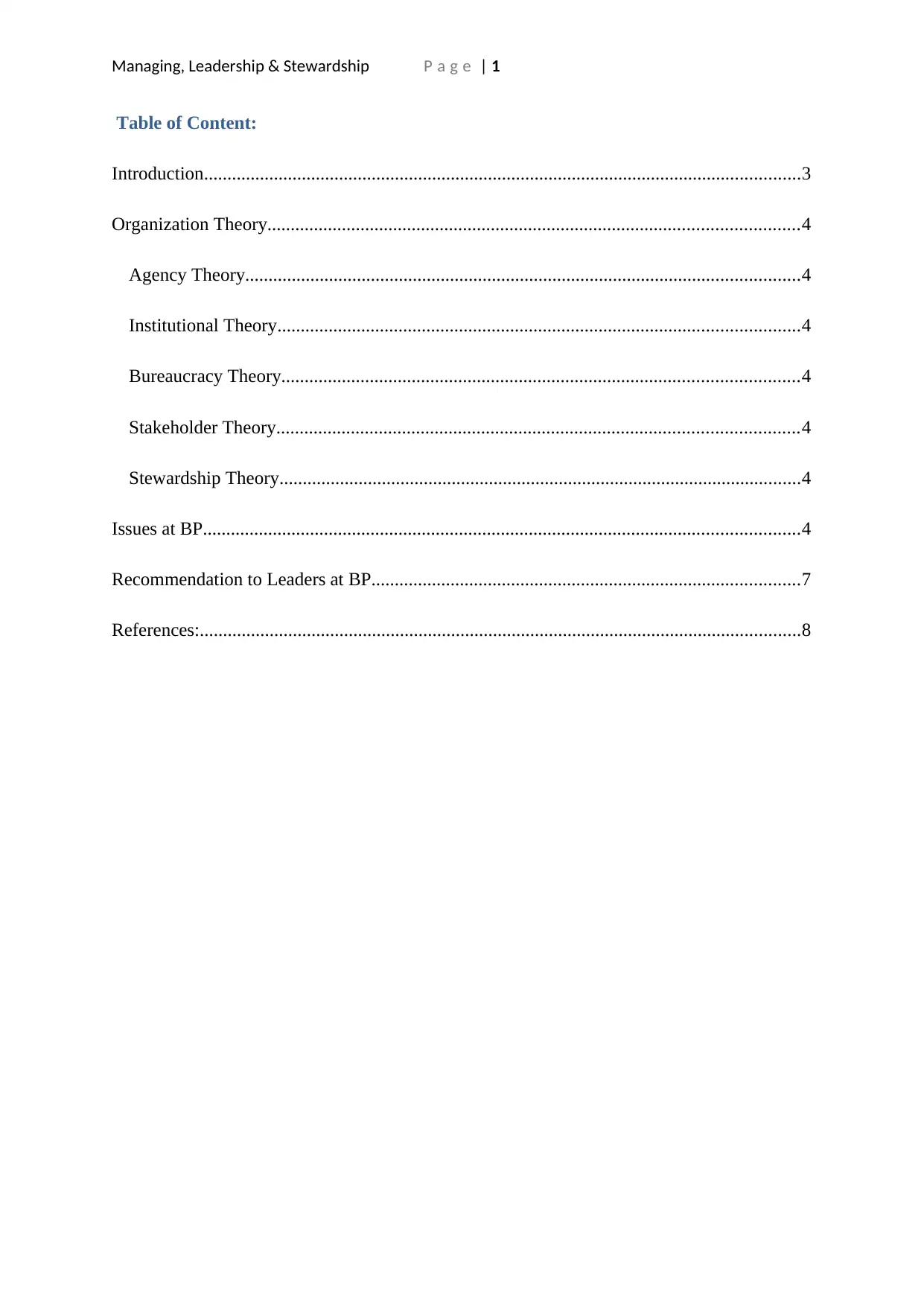
Managing, Leadership & Stewardship P a g e | 1
Table of Content:
Introduction................................................................................................................................3
Organization Theory..................................................................................................................4
Agency Theory.......................................................................................................................4
Institutional Theory................................................................................................................4
Bureaucracy Theory...............................................................................................................4
Stakeholder Theory................................................................................................................4
Stewardship Theory................................................................................................................4
Issues at BP................................................................................................................................4
Recommendation to Leaders at BP............................................................................................7
References:.................................................................................................................................8
Table of Content:
Introduction................................................................................................................................3
Organization Theory..................................................................................................................4
Agency Theory.......................................................................................................................4
Institutional Theory................................................................................................................4
Bureaucracy Theory...............................................................................................................4
Stakeholder Theory................................................................................................................4
Stewardship Theory................................................................................................................4
Issues at BP................................................................................................................................4
Recommendation to Leaders at BP............................................................................................7
References:.................................................................................................................................8
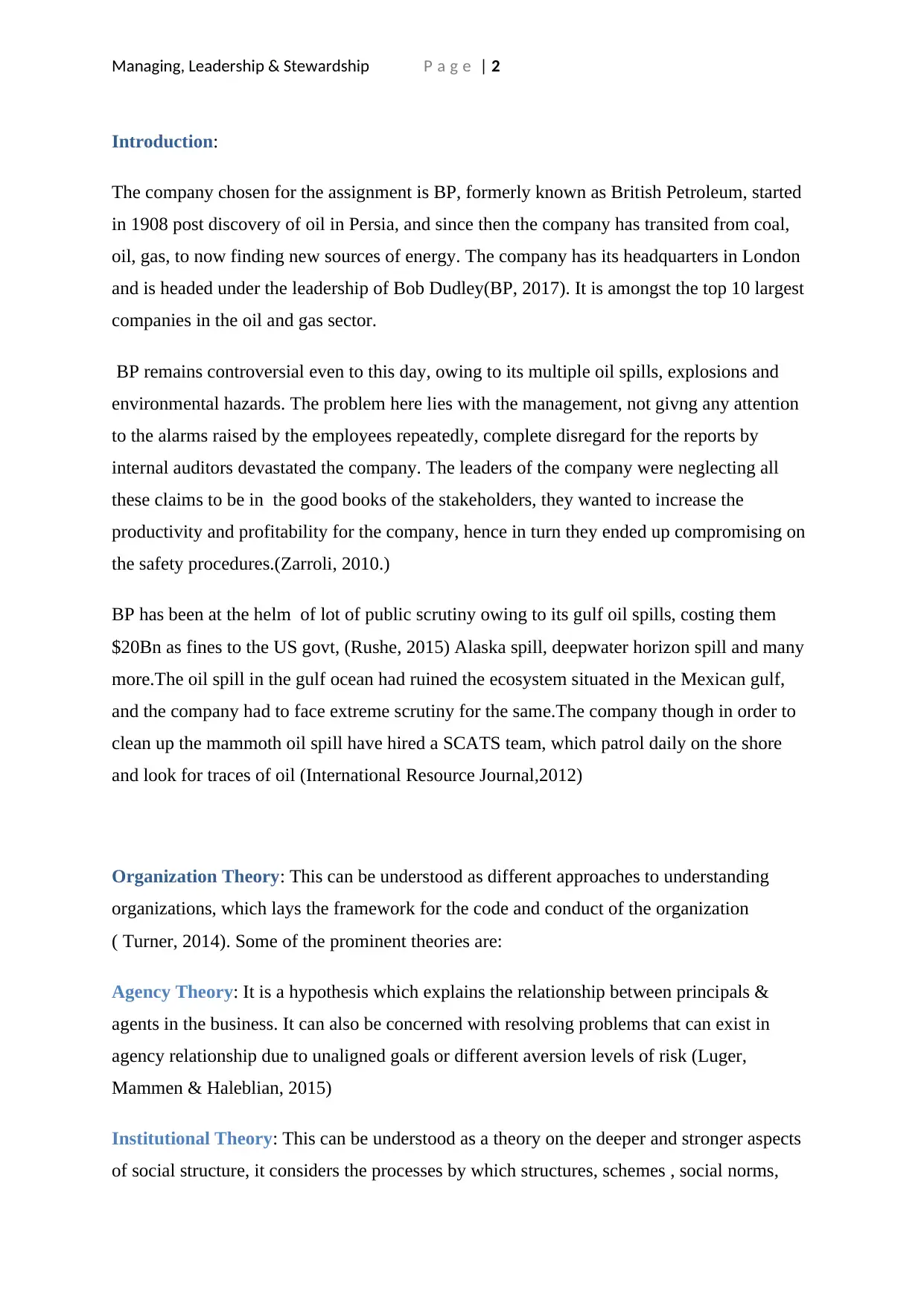
Managing, Leadership & Stewardship P a g e | 2
Introduction:
The company chosen for the assignment is BP, formerly known as British Petroleum, started
in 1908 post discovery of oil in Persia, and since then the company has transited from coal,
oil, gas, to now finding new sources of energy. The company has its headquarters in London
and is headed under the leadership of Bob Dudley(BP, 2017). It is amongst the top 10 largest
companies in the oil and gas sector.
BP remains controversial even to this day, owing to its multiple oil spills, explosions and
environmental hazards. The problem here lies with the management, not givng any attention
to the alarms raised by the employees repeatedly, complete disregard for the reports by
internal auditors devastated the company. The leaders of the company were neglecting all
these claims to be in the good books of the stakeholders, they wanted to increase the
productivity and profitability for the company, hence in turn they ended up compromising on
the safety procedures.(Zarroli, 2010.)
BP has been at the helm of lot of public scrutiny owing to its gulf oil spills, costing them
$20Bn as fines to the US govt, (Rushe, 2015) Alaska spill, deepwater horizon spill and many
more.The oil spill in the gulf ocean had ruined the ecosystem situated in the Mexican gulf,
and the company had to face extreme scrutiny for the same.The company though in order to
clean up the mammoth oil spill have hired a SCATS team, which patrol daily on the shore
and look for traces of oil (International Resource Journal,2012)
Organization Theory: This can be understood as different approaches to understanding
organizations, which lays the framework for the code and conduct of the organization
( Turner, 2014). Some of the prominent theories are:
Agency Theory: It is a hypothesis which explains the relationship between principals &
agents in the business. It can also be concerned with resolving problems that can exist in
agency relationship due to unaligned goals or different aversion levels of risk (Luger,
Mammen & Haleblian, 2015)
Institutional Theory: This can be understood as a theory on the deeper and stronger aspects
of social structure, it considers the processes by which structures, schemes , social norms,
Introduction:
The company chosen for the assignment is BP, formerly known as British Petroleum, started
in 1908 post discovery of oil in Persia, and since then the company has transited from coal,
oil, gas, to now finding new sources of energy. The company has its headquarters in London
and is headed under the leadership of Bob Dudley(BP, 2017). It is amongst the top 10 largest
companies in the oil and gas sector.
BP remains controversial even to this day, owing to its multiple oil spills, explosions and
environmental hazards. The problem here lies with the management, not givng any attention
to the alarms raised by the employees repeatedly, complete disregard for the reports by
internal auditors devastated the company. The leaders of the company were neglecting all
these claims to be in the good books of the stakeholders, they wanted to increase the
productivity and profitability for the company, hence in turn they ended up compromising on
the safety procedures.(Zarroli, 2010.)
BP has been at the helm of lot of public scrutiny owing to its gulf oil spills, costing them
$20Bn as fines to the US govt, (Rushe, 2015) Alaska spill, deepwater horizon spill and many
more.The oil spill in the gulf ocean had ruined the ecosystem situated in the Mexican gulf,
and the company had to face extreme scrutiny for the same.The company though in order to
clean up the mammoth oil spill have hired a SCATS team, which patrol daily on the shore
and look for traces of oil (International Resource Journal,2012)
Organization Theory: This can be understood as different approaches to understanding
organizations, which lays the framework for the code and conduct of the organization
( Turner, 2014). Some of the prominent theories are:
Agency Theory: It is a hypothesis which explains the relationship between principals &
agents in the business. It can also be concerned with resolving problems that can exist in
agency relationship due to unaligned goals or different aversion levels of risk (Luger,
Mammen & Haleblian, 2015)
Institutional Theory: This can be understood as a theory on the deeper and stronger aspects
of social structure, it considers the processes by which structures, schemes , social norms,
⊘ This is a preview!⊘
Do you want full access?
Subscribe today to unlock all pages.

Trusted by 1+ million students worldwide
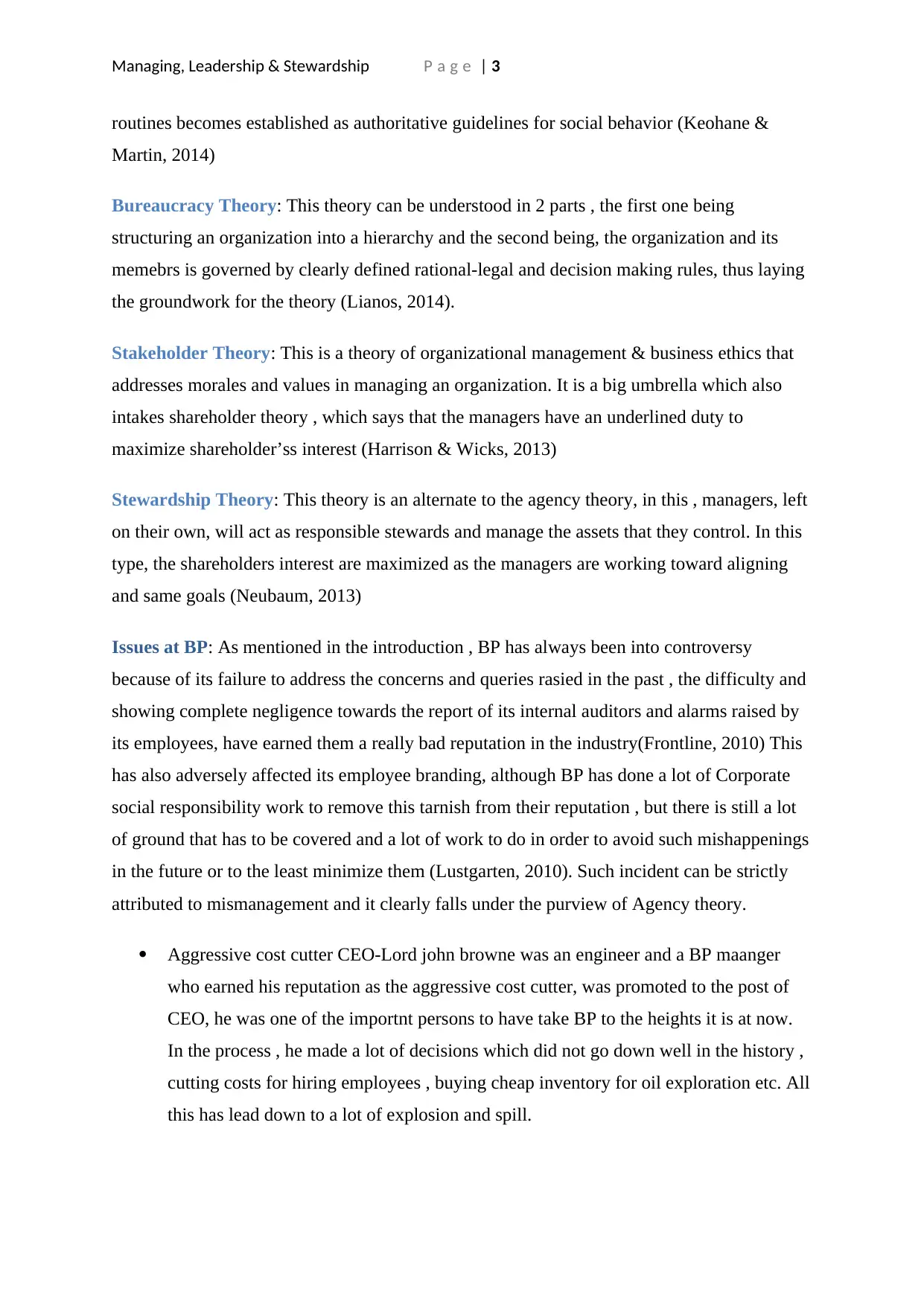
Managing, Leadership & Stewardship P a g e | 3
routines becomes established as authoritative guidelines for social behavior (Keohane &
Martin, 2014)
Bureaucracy Theory: This theory can be understood in 2 parts , the first one being
structuring an organization into a hierarchy and the second being, the organization and its
memebrs is governed by clearly defined rational-legal and decision making rules, thus laying
the groundwork for the theory (Lianos, 2014).
Stakeholder Theory: This is a theory of organizational management & business ethics that
addresses morales and values in managing an organization. It is a big umbrella which also
intakes shareholder theory , which says that the managers have an underlined duty to
maximize shareholder’ss interest (Harrison & Wicks, 2013)
Stewardship Theory: This theory is an alternate to the agency theory, in this , managers, left
on their own, will act as responsible stewards and manage the assets that they control. In this
type, the shareholders interest are maximized as the managers are working toward aligning
and same goals (Neubaum, 2013)
Issues at BP: As mentioned in the introduction , BP has always been into controversy
because of its failure to address the concerns and queries rasied in the past , the difficulty and
showing complete negligence towards the report of its internal auditors and alarms raised by
its employees, have earned them a really bad reputation in the industry(Frontline, 2010) This
has also adversely affected its employee branding, although BP has done a lot of Corporate
social responsibility work to remove this tarnish from their reputation , but there is still a lot
of ground that has to be covered and a lot of work to do in order to avoid such mishappenings
in the future or to the least minimize them (Lustgarten, 2010). Such incident can be strictly
attributed to mismanagement and it clearly falls under the purview of Agency theory.
Aggressive cost cutter CEO-Lord john browne was an engineer and a BP maanger
who earned his reputation as the aggressive cost cutter, was promoted to the post of
CEO, he was one of the importnt persons to have take BP to the heights it is at now.
In the process , he made a lot of decisions which did not go down well in the history ,
cutting costs for hiring employees , buying cheap inventory for oil exploration etc. All
this has lead down to a lot of explosion and spill.
routines becomes established as authoritative guidelines for social behavior (Keohane &
Martin, 2014)
Bureaucracy Theory: This theory can be understood in 2 parts , the first one being
structuring an organization into a hierarchy and the second being, the organization and its
memebrs is governed by clearly defined rational-legal and decision making rules, thus laying
the groundwork for the theory (Lianos, 2014).
Stakeholder Theory: This is a theory of organizational management & business ethics that
addresses morales and values in managing an organization. It is a big umbrella which also
intakes shareholder theory , which says that the managers have an underlined duty to
maximize shareholder’ss interest (Harrison & Wicks, 2013)
Stewardship Theory: This theory is an alternate to the agency theory, in this , managers, left
on their own, will act as responsible stewards and manage the assets that they control. In this
type, the shareholders interest are maximized as the managers are working toward aligning
and same goals (Neubaum, 2013)
Issues at BP: As mentioned in the introduction , BP has always been into controversy
because of its failure to address the concerns and queries rasied in the past , the difficulty and
showing complete negligence towards the report of its internal auditors and alarms raised by
its employees, have earned them a really bad reputation in the industry(Frontline, 2010) This
has also adversely affected its employee branding, although BP has done a lot of Corporate
social responsibility work to remove this tarnish from their reputation , but there is still a lot
of ground that has to be covered and a lot of work to do in order to avoid such mishappenings
in the future or to the least minimize them (Lustgarten, 2010). Such incident can be strictly
attributed to mismanagement and it clearly falls under the purview of Agency theory.
Aggressive cost cutter CEO-Lord john browne was an engineer and a BP maanger
who earned his reputation as the aggressive cost cutter, was promoted to the post of
CEO, he was one of the importnt persons to have take BP to the heights it is at now.
In the process , he made a lot of decisions which did not go down well in the history ,
cutting costs for hiring employees , buying cheap inventory for oil exploration etc. All
this has lead down to a lot of explosion and spill.
Paraphrase This Document
Need a fresh take? Get an instant paraphrase of this document with our AI Paraphraser
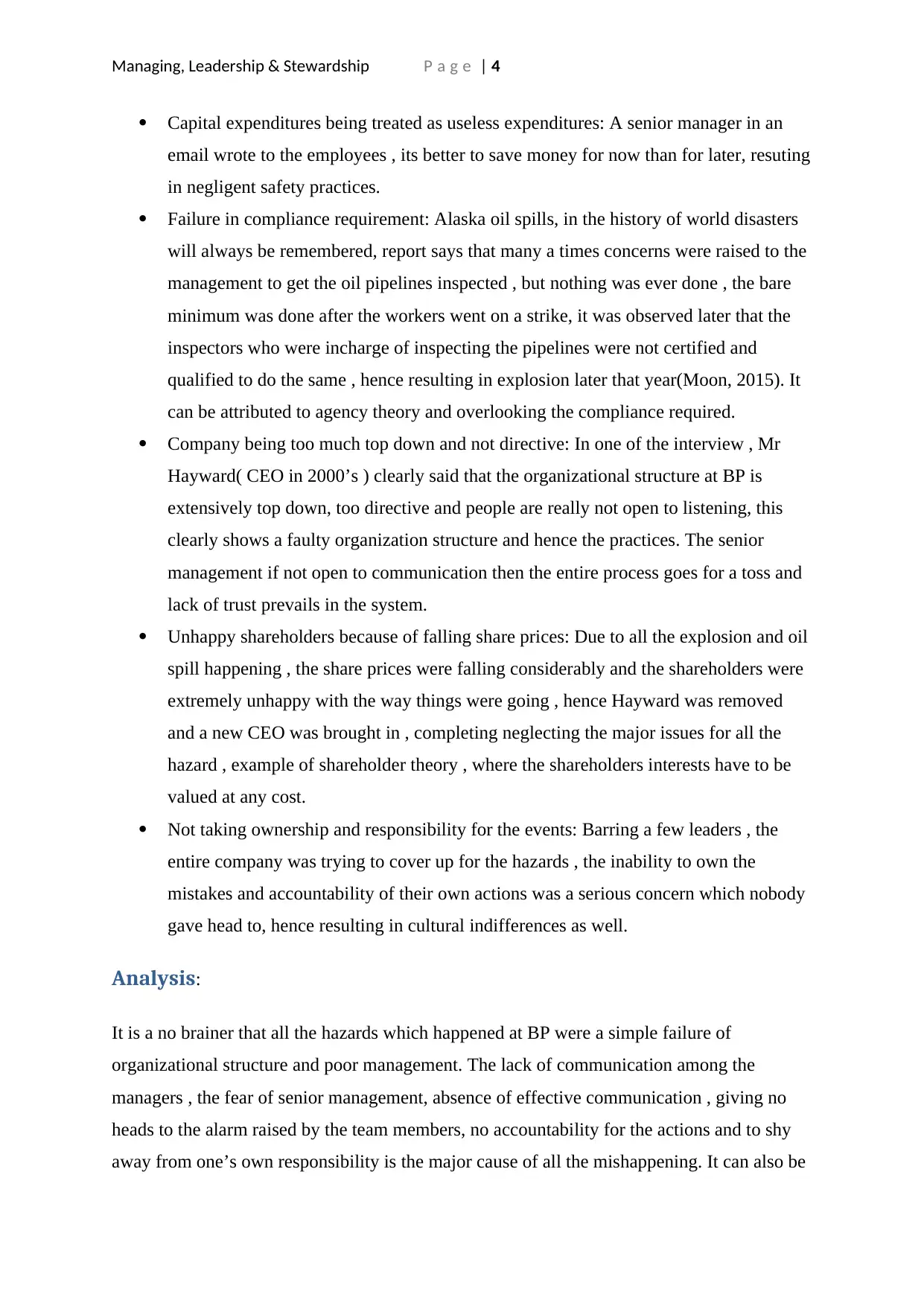
Managing, Leadership & Stewardship P a g e | 4
Capital expenditures being treated as useless expenditures: A senior manager in an
email wrote to the employees , its better to save money for now than for later, resuting
in negligent safety practices.
Failure in compliance requirement: Alaska oil spills, in the history of world disasters
will always be remembered, report says that many a times concerns were raised to the
management to get the oil pipelines inspected , but nothing was ever done , the bare
minimum was done after the workers went on a strike, it was observed later that the
inspectors who were incharge of inspecting the pipelines were not certified and
qualified to do the same , hence resulting in explosion later that year(Moon, 2015). It
can be attributed to agency theory and overlooking the compliance required.
Company being too much top down and not directive: In one of the interview , Mr
Hayward( CEO in 2000’s ) clearly said that the organizational structure at BP is
extensively top down, too directive and people are really not open to listening, this
clearly shows a faulty organization structure and hence the practices. The senior
management if not open to communication then the entire process goes for a toss and
lack of trust prevails in the system.
Unhappy shareholders because of falling share prices: Due to all the explosion and oil
spill happening , the share prices were falling considerably and the shareholders were
extremely unhappy with the way things were going , hence Hayward was removed
and a new CEO was brought in , completing neglecting the major issues for all the
hazard , example of shareholder theory , where the shareholders interests have to be
valued at any cost.
Not taking ownership and responsibility for the events: Barring a few leaders , the
entire company was trying to cover up for the hazards , the inability to own the
mistakes and accountability of their own actions was a serious concern which nobody
gave head to, hence resulting in cultural indifferences as well.
Analysis:
It is a no brainer that all the hazards which happened at BP were a simple failure of
organizational structure and poor management. The lack of communication among the
managers , the fear of senior management, absence of effective communication , giving no
heads to the alarm raised by the team members, no accountability for the actions and to shy
away from one’s own responsibility is the major cause of all the mishappening. It can also be
Capital expenditures being treated as useless expenditures: A senior manager in an
email wrote to the employees , its better to save money for now than for later, resuting
in negligent safety practices.
Failure in compliance requirement: Alaska oil spills, in the history of world disasters
will always be remembered, report says that many a times concerns were raised to the
management to get the oil pipelines inspected , but nothing was ever done , the bare
minimum was done after the workers went on a strike, it was observed later that the
inspectors who were incharge of inspecting the pipelines were not certified and
qualified to do the same , hence resulting in explosion later that year(Moon, 2015). It
can be attributed to agency theory and overlooking the compliance required.
Company being too much top down and not directive: In one of the interview , Mr
Hayward( CEO in 2000’s ) clearly said that the organizational structure at BP is
extensively top down, too directive and people are really not open to listening, this
clearly shows a faulty organization structure and hence the practices. The senior
management if not open to communication then the entire process goes for a toss and
lack of trust prevails in the system.
Unhappy shareholders because of falling share prices: Due to all the explosion and oil
spill happening , the share prices were falling considerably and the shareholders were
extremely unhappy with the way things were going , hence Hayward was removed
and a new CEO was brought in , completing neglecting the major issues for all the
hazard , example of shareholder theory , where the shareholders interests have to be
valued at any cost.
Not taking ownership and responsibility for the events: Barring a few leaders , the
entire company was trying to cover up for the hazards , the inability to own the
mistakes and accountability of their own actions was a serious concern which nobody
gave head to, hence resulting in cultural indifferences as well.
Analysis:
It is a no brainer that all the hazards which happened at BP were a simple failure of
organizational structure and poor management. The lack of communication among the
managers , the fear of senior management, absence of effective communication , giving no
heads to the alarm raised by the team members, no accountability for the actions and to shy
away from one’s own responsibility is the major cause of all the mishappening. It can also be
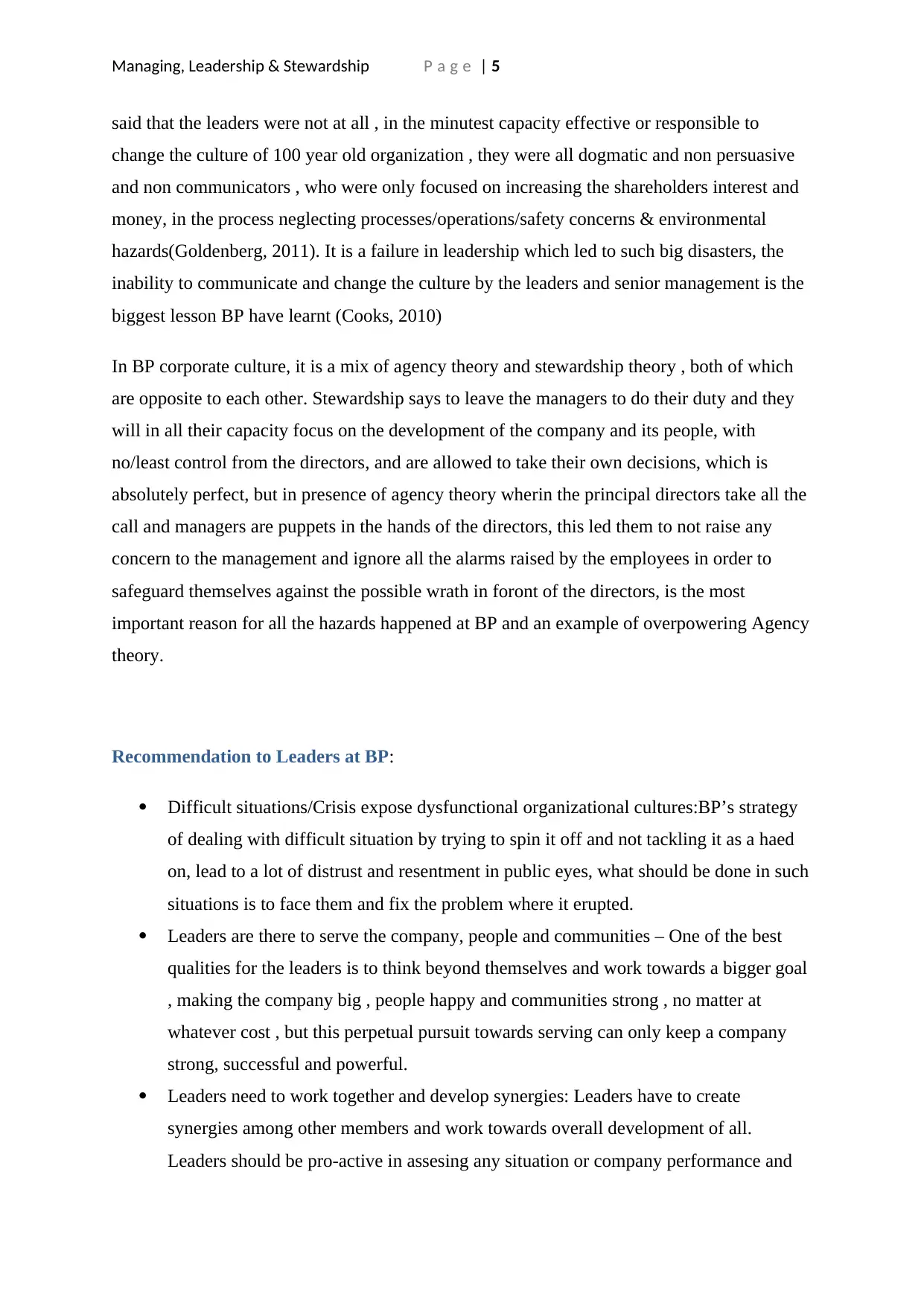
Managing, Leadership & Stewardship P a g e | 5
said that the leaders were not at all , in the minutest capacity effective or responsible to
change the culture of 100 year old organization , they were all dogmatic and non persuasive
and non communicators , who were only focused on increasing the shareholders interest and
money, in the process neglecting processes/operations/safety concerns & environmental
hazards(Goldenberg, 2011). It is a failure in leadership which led to such big disasters, the
inability to communicate and change the culture by the leaders and senior management is the
biggest lesson BP have learnt (Cooks, 2010)
In BP corporate culture, it is a mix of agency theory and stewardship theory , both of which
are opposite to each other. Stewardship says to leave the managers to do their duty and they
will in all their capacity focus on the development of the company and its people, with
no/least control from the directors, and are allowed to take their own decisions, which is
absolutely perfect, but in presence of agency theory wherin the principal directors take all the
call and managers are puppets in the hands of the directors, this led them to not raise any
concern to the management and ignore all the alarms raised by the employees in order to
safeguard themselves against the possible wrath in foront of the directors, is the most
important reason for all the hazards happened at BP and an example of overpowering Agency
theory.
Recommendation to Leaders at BP:
Difficult situations/Crisis expose dysfunctional organizational cultures:BP’s strategy
of dealing with difficult situation by trying to spin it off and not tackling it as a haed
on, lead to a lot of distrust and resentment in public eyes, what should be done in such
situations is to face them and fix the problem where it erupted.
Leaders are there to serve the company, people and communities – One of the best
qualities for the leaders is to think beyond themselves and work towards a bigger goal
, making the company big , people happy and communities strong , no matter at
whatever cost , but this perpetual pursuit towards serving can only keep a company
strong, successful and powerful.
Leaders need to work together and develop synergies: Leaders have to create
synergies among other members and work towards overall development of all.
Leaders should be pro-active in assesing any situation or company performance and
said that the leaders were not at all , in the minutest capacity effective or responsible to
change the culture of 100 year old organization , they were all dogmatic and non persuasive
and non communicators , who were only focused on increasing the shareholders interest and
money, in the process neglecting processes/operations/safety concerns & environmental
hazards(Goldenberg, 2011). It is a failure in leadership which led to such big disasters, the
inability to communicate and change the culture by the leaders and senior management is the
biggest lesson BP have learnt (Cooks, 2010)
In BP corporate culture, it is a mix of agency theory and stewardship theory , both of which
are opposite to each other. Stewardship says to leave the managers to do their duty and they
will in all their capacity focus on the development of the company and its people, with
no/least control from the directors, and are allowed to take their own decisions, which is
absolutely perfect, but in presence of agency theory wherin the principal directors take all the
call and managers are puppets in the hands of the directors, this led them to not raise any
concern to the management and ignore all the alarms raised by the employees in order to
safeguard themselves against the possible wrath in foront of the directors, is the most
important reason for all the hazards happened at BP and an example of overpowering Agency
theory.
Recommendation to Leaders at BP:
Difficult situations/Crisis expose dysfunctional organizational cultures:BP’s strategy
of dealing with difficult situation by trying to spin it off and not tackling it as a haed
on, lead to a lot of distrust and resentment in public eyes, what should be done in such
situations is to face them and fix the problem where it erupted.
Leaders are there to serve the company, people and communities – One of the best
qualities for the leaders is to think beyond themselves and work towards a bigger goal
, making the company big , people happy and communities strong , no matter at
whatever cost , but this perpetual pursuit towards serving can only keep a company
strong, successful and powerful.
Leaders need to work together and develop synergies: Leaders have to create
synergies among other members and work towards overall development of all.
Leaders should be pro-active in assesing any situation or company performance and
⊘ This is a preview!⊘
Do you want full access?
Subscribe today to unlock all pages.

Trusted by 1+ million students worldwide
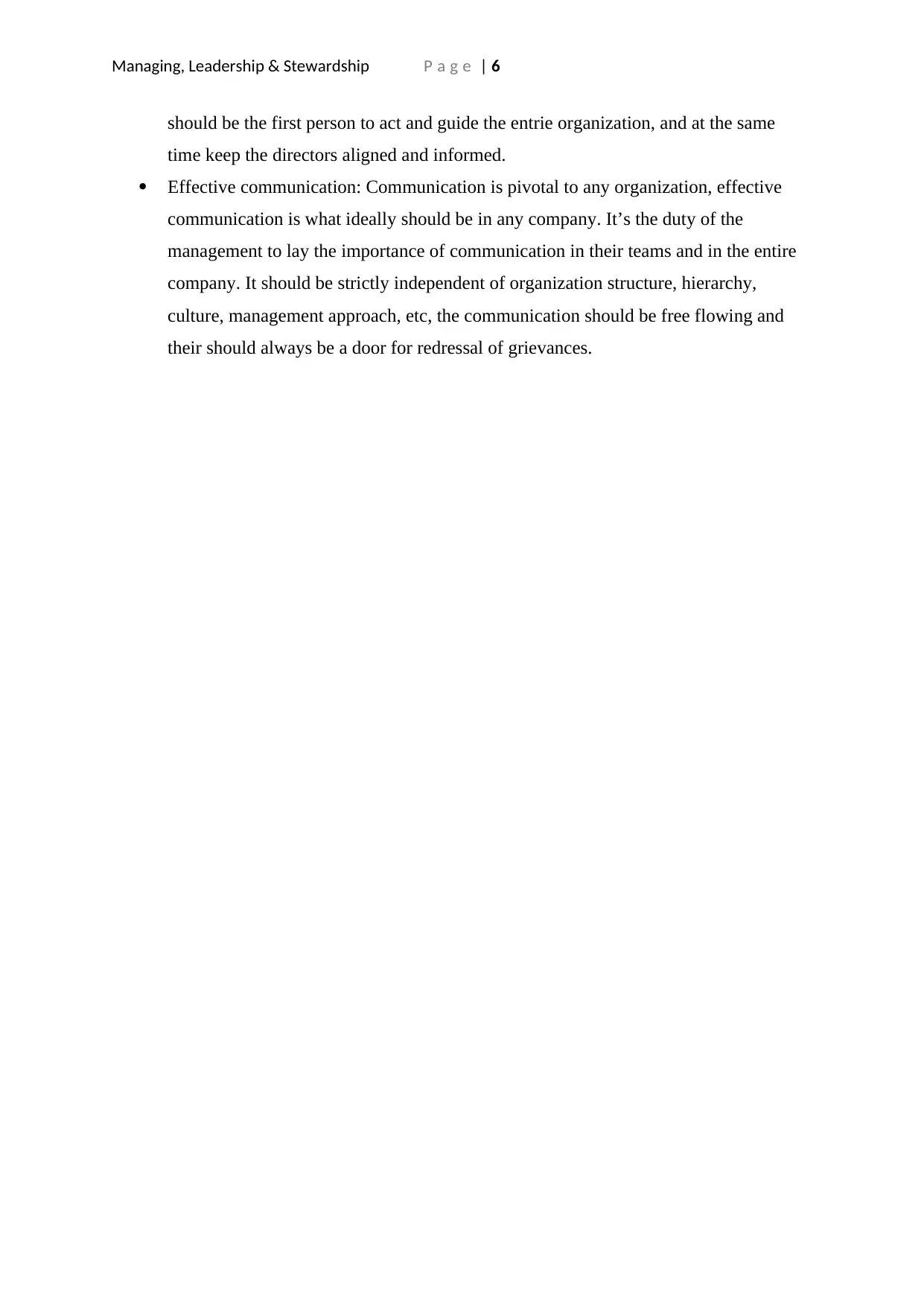
Managing, Leadership & Stewardship P a g e | 6
should be the first person to act and guide the entrie organization, and at the same
time keep the directors aligned and informed.
Effective communication: Communication is pivotal to any organization, effective
communication is what ideally should be in any company. It’s the duty of the
management to lay the importance of communication in their teams and in the entire
company. It should be strictly independent of organization structure, hierarchy,
culture, management approach, etc, the communication should be free flowing and
their should always be a door for redressal of grievances.
should be the first person to act and guide the entrie organization, and at the same
time keep the directors aligned and informed.
Effective communication: Communication is pivotal to any organization, effective
communication is what ideally should be in any company. It’s the duty of the
management to lay the importance of communication in their teams and in the entire
company. It should be strictly independent of organization structure, hierarchy,
culture, management approach, etc, the communication should be free flowing and
their should always be a door for redressal of grievances.
Paraphrase This Document
Need a fresh take? Get an instant paraphrase of this document with our AI Paraphraser
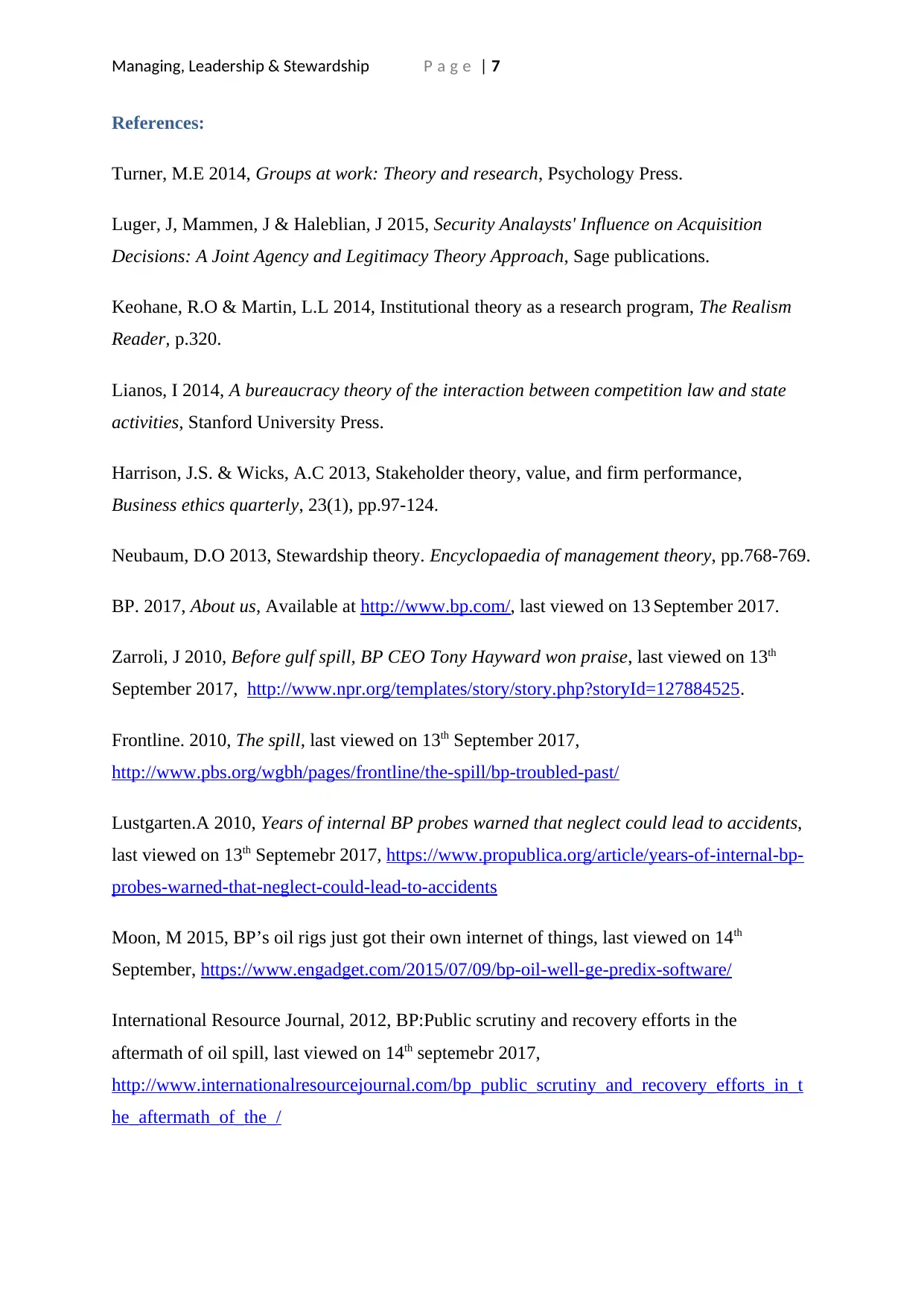
Managing, Leadership & Stewardship P a g e | 7
References:
Turner, M.E 2014, Groups at work: Theory and research, Psychology Press.
Luger, J, Mammen, J & Haleblian, J 2015, Security Analaysts' Influence on Acquisition
Decisions: A Joint Agency and Legitimacy Theory Approach, Sage publications.
Keohane, R.O & Martin, L.L 2014, Institutional theory as a research program, The Realism
Reader, p.320.
Lianos, I 2014, A bureaucracy theory of the interaction between competition law and state
activities, Stanford University Press.
Harrison, J.S. & Wicks, A.C 2013, Stakeholder theory, value, and firm performance,
Business ethics quarterly, 23(1), pp.97-124.
Neubaum, D.O 2013, Stewardship theory. Encyclopaedia of management theory, pp.768-769.
BP. 2017, About us, Available at http://www.bp.com/, last viewed on 13 September 2017.
Zarroli, J 2010, Before gulf spill, BP CEO Tony Hayward won praise, last viewed on 13th
September 2017, http://www.npr.org/templates/story/story.php?storyId=127884525.
Frontline. 2010, The spill, last viewed on 13th September 2017,
http://www.pbs.org/wgbh/pages/frontline/the-spill/bp-troubled-past/
Lustgarten.A 2010, Years of internal BP probes warned that neglect could lead to accidents,
last viewed on 13th Septemebr 2017, https://www.propublica.org/article/years-of-internal-bp-
probes-warned-that-neglect-could-lead-to-accidents
Moon, M 2015, BP’s oil rigs just got their own internet of things, last viewed on 14th
September, https://www.engadget.com/2015/07/09/bp-oil-well-ge-predix-software/
International Resource Journal, 2012, BP:Public scrutiny and recovery efforts in the
aftermath of oil spill, last viewed on 14th septemebr 2017,
http://www.internationalresourcejournal.com/bp_public_scrutiny_and_recovery_efforts_in_t
he_aftermath_of_the_/
References:
Turner, M.E 2014, Groups at work: Theory and research, Psychology Press.
Luger, J, Mammen, J & Haleblian, J 2015, Security Analaysts' Influence on Acquisition
Decisions: A Joint Agency and Legitimacy Theory Approach, Sage publications.
Keohane, R.O & Martin, L.L 2014, Institutional theory as a research program, The Realism
Reader, p.320.
Lianos, I 2014, A bureaucracy theory of the interaction between competition law and state
activities, Stanford University Press.
Harrison, J.S. & Wicks, A.C 2013, Stakeholder theory, value, and firm performance,
Business ethics quarterly, 23(1), pp.97-124.
Neubaum, D.O 2013, Stewardship theory. Encyclopaedia of management theory, pp.768-769.
BP. 2017, About us, Available at http://www.bp.com/, last viewed on 13 September 2017.
Zarroli, J 2010, Before gulf spill, BP CEO Tony Hayward won praise, last viewed on 13th
September 2017, http://www.npr.org/templates/story/story.php?storyId=127884525.
Frontline. 2010, The spill, last viewed on 13th September 2017,
http://www.pbs.org/wgbh/pages/frontline/the-spill/bp-troubled-past/
Lustgarten.A 2010, Years of internal BP probes warned that neglect could lead to accidents,
last viewed on 13th Septemebr 2017, https://www.propublica.org/article/years-of-internal-bp-
probes-warned-that-neglect-could-lead-to-accidents
Moon, M 2015, BP’s oil rigs just got their own internet of things, last viewed on 14th
September, https://www.engadget.com/2015/07/09/bp-oil-well-ge-predix-software/
International Resource Journal, 2012, BP:Public scrutiny and recovery efforts in the
aftermath of oil spill, last viewed on 14th septemebr 2017,
http://www.internationalresourcejournal.com/bp_public_scrutiny_and_recovery_efforts_in_t
he_aftermath_of_the_/
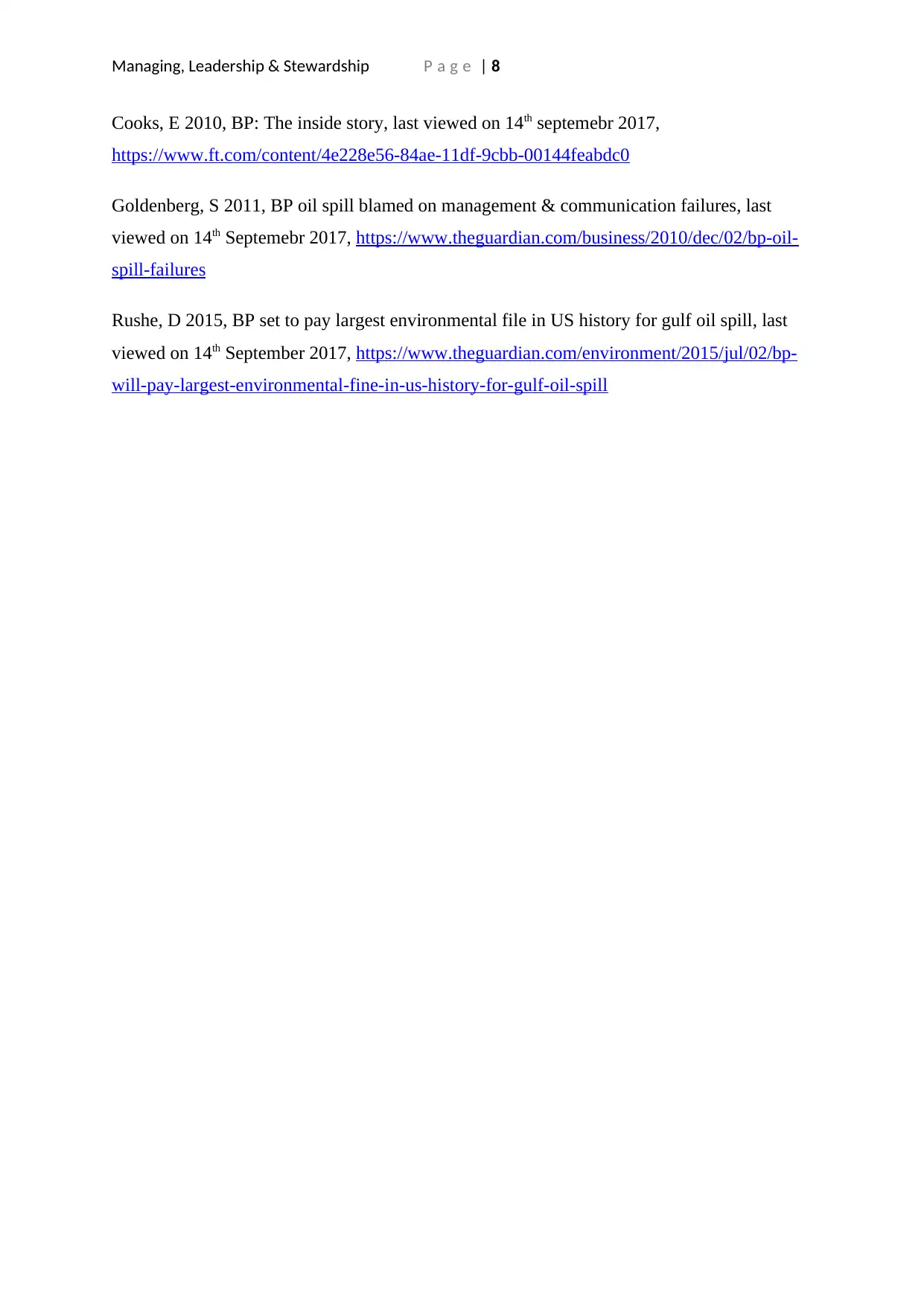
Managing, Leadership & Stewardship P a g e | 8
Cooks, E 2010, BP: The inside story, last viewed on 14th septemebr 2017,
https://www.ft.com/content/4e228e56-84ae-11df-9cbb-00144feabdc0
Goldenberg, S 2011, BP oil spill blamed on management & communication failures, last
viewed on 14th Septemebr 2017, https://www.theguardian.com/business/2010/dec/02/bp-oil-
spill-failures
Rushe, D 2015, BP set to pay largest environmental file in US history for gulf oil spill, last
viewed on 14th September 2017, https://www.theguardian.com/environment/2015/jul/02/bp-
will-pay-largest-environmental-fine-in-us-history-for-gulf-oil-spill
Cooks, E 2010, BP: The inside story, last viewed on 14th septemebr 2017,
https://www.ft.com/content/4e228e56-84ae-11df-9cbb-00144feabdc0
Goldenberg, S 2011, BP oil spill blamed on management & communication failures, last
viewed on 14th Septemebr 2017, https://www.theguardian.com/business/2010/dec/02/bp-oil-
spill-failures
Rushe, D 2015, BP set to pay largest environmental file in US history for gulf oil spill, last
viewed on 14th September 2017, https://www.theguardian.com/environment/2015/jul/02/bp-
will-pay-largest-environmental-fine-in-us-history-for-gulf-oil-spill
⊘ This is a preview!⊘
Do you want full access?
Subscribe today to unlock all pages.

Trusted by 1+ million students worldwide
1 out of 9
Related Documents
Your All-in-One AI-Powered Toolkit for Academic Success.
+13062052269
info@desklib.com
Available 24*7 on WhatsApp / Email
![[object Object]](/_next/static/media/star-bottom.7253800d.svg)
Unlock your academic potential
Copyright © 2020–2025 A2Z Services. All Rights Reserved. Developed and managed by ZUCOL.





